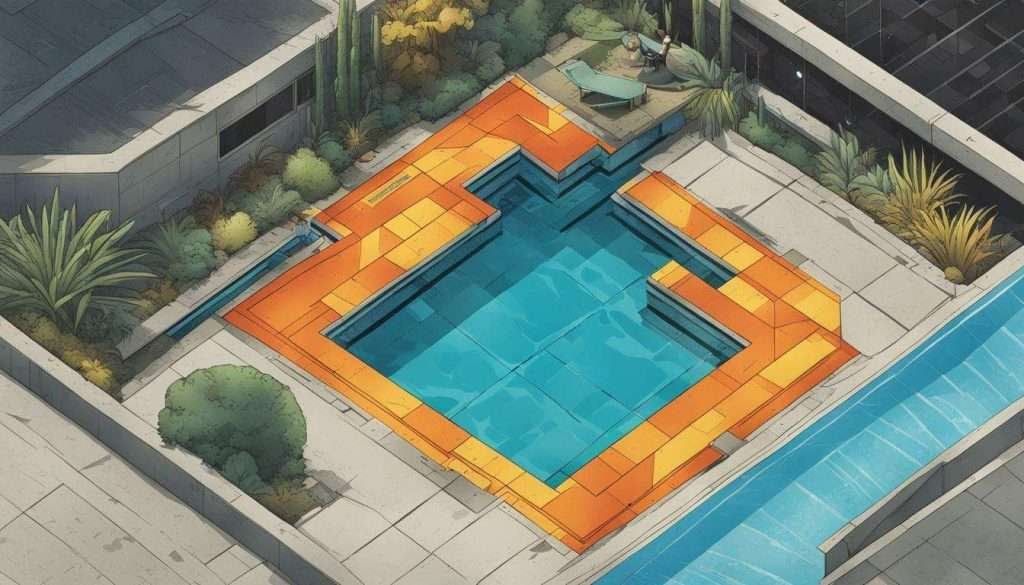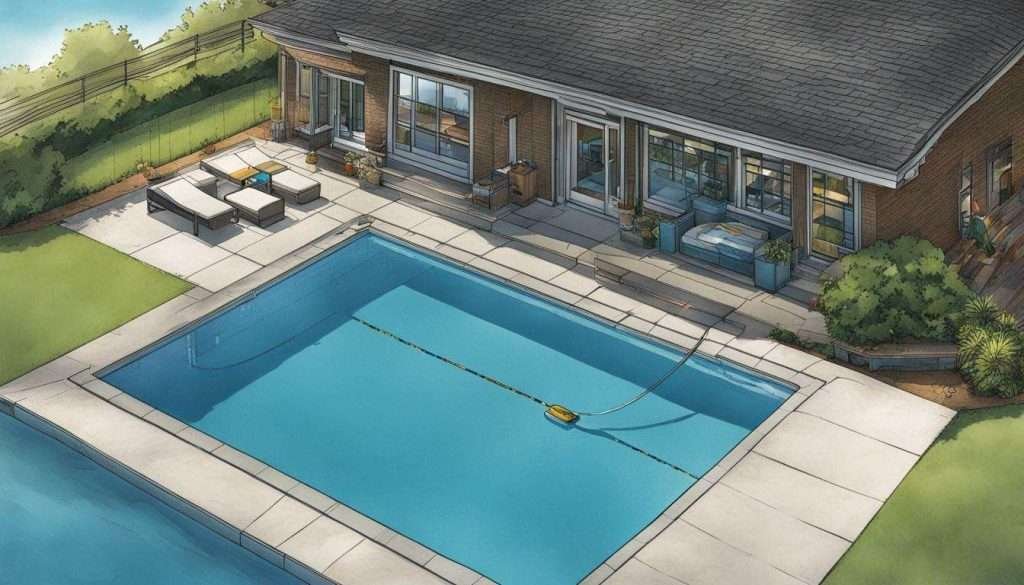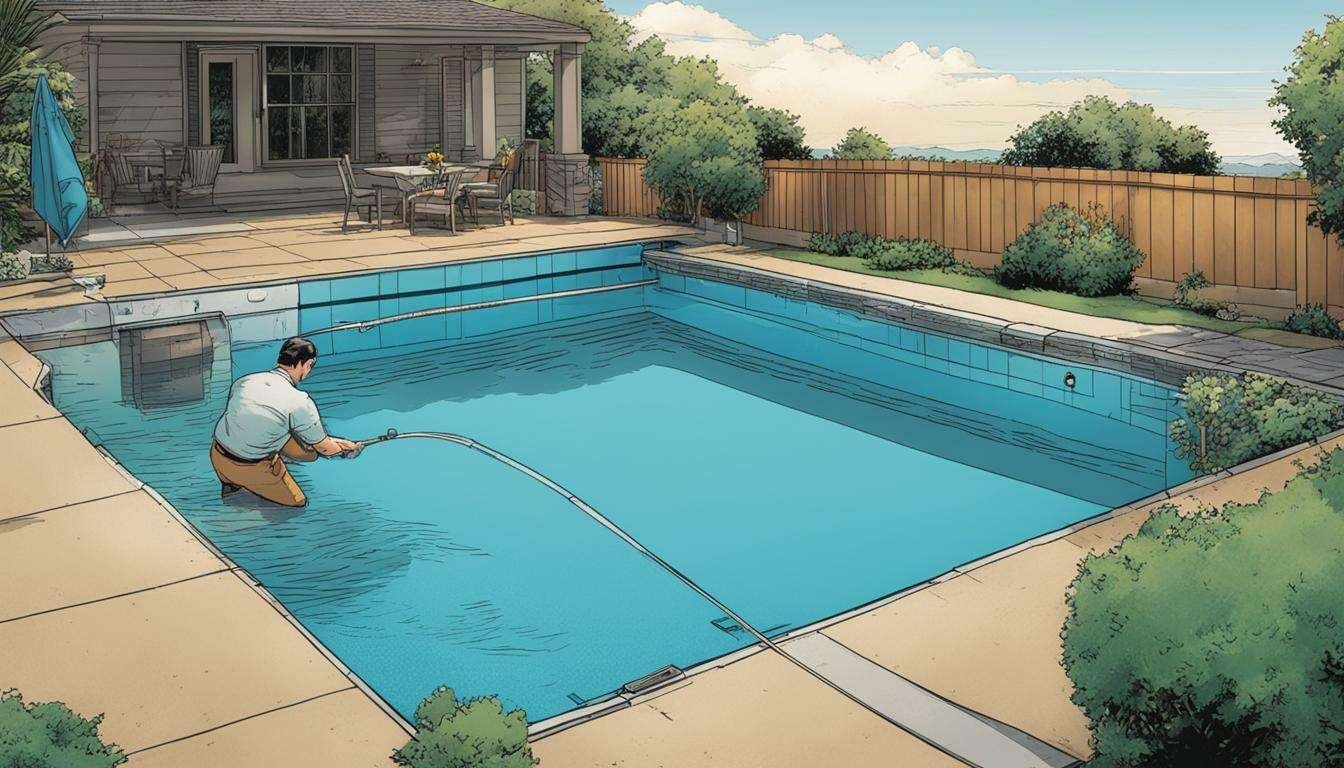Identifying the shape of your pool
Before you start measuring your pool, it’s essential to identify the shape of your pool, as different shapes require different measuring techniques. This step is crucial to ensure accurate measurements for your pool cover. Whether you have a standard geometrical pool or a custom or irregularly shaped pool, knowing the shape is the first step towards a perfect fitting cover.
If you have a standard geometrical pool, such as rectangular, oval, or kidney-shaped, you can use standard measuring methods. Start by measuring the length of each perimeter line, ensuring you follow the curvature of the pool. Then measure the length and width of each section, taking into account any non-removable pool features that may protrude into the pool. These measurements will give you the dimensions needed for your pool cover. When it comes to selecting pool cover materials, it’s important to consider factors such as durability, UV resistance, and ease of installation. Some popular options include vinyl, mesh, and solid safety covers. Vinyl covers provide a solid barrier and are ideal for keeping debris out of the pool, while mesh covers allow water to pass through and are great for maintaining water quality. Solid safety covers provide the most protection but may require a pump to remove standing water. Take into consideration your specific pool needs and local climate when choosing the best cover material for your pool.
For custom or irregularly shaped pools, the AB measuring technique is used. This involves establishing two points, usually opposite each other, and marking additional points around the pool. Measure the distance between these two points (A and B), as well as the distance from points A and B to the other marked points. This method allows for precise measurements of irregular shapes, ensuring your cover fits snugly.
Once you have noted down all the measurements, you can fill out a custom pool cover measurement form. When ordering your pool cover, it’s advisable to consider ordering a size up from your measurements. This ensures a snug fit and allows for any slight variations. Additionally, it’s important to consult the instructions provided by your pool cover manufacturer, as they may have specific guidelines or recommendations for measuring and ordering the perfect fitting cover for your pool.
Example image of measuring a pool for a cover:
| Pool Shape | Measuring Technique |
|---|---|
| Rectangular | Standard measuring methods |
| Oval | Standard measuring methods |
| Kidney-shaped | Standard measuring methods |
| Custom or irregularly shaped | AB measuring technique |
Standard measuring methods for geometrical pools
If you have a standard geometrical pool, you can follow these standard measuring methods to ensure accurate measurements for your pool cover. Start by measuring the length of each perimeter line of your pool. This can be done by using a measuring tape or a string that you can later measure.
Next, measure the length and width of each section of your pool. You can divide your pool into sections, such as the shallow end, deep end, and any other distinct areas. Measure the length from one end to another, and the width from one side to another. Take note of these measurements as they will be important when ordering your pool cover.
It is also essential to consider any non-removable pool features that may affect the measurements. If you have steps, ladders, or other protrusions in your pool, measure how much they extend into the pool. This will ensure that your pool cover fits correctly and does not interfere with these features.
| Pool Section | Length (ft) | Width (ft) |
|---|---|---|
| Shallow End | 30 | 15 |
| Deep End | 40 | 20 |
“Accurate measurements are crucial when ordering a pool cover. Taking the time to measure your pool correctly will ensure that you receive a cover that fits perfectly and provides optimal protection.”
Standard Measuring Checklist:
- Measure the length of perimeter lines
- Measure the length and width of each pool section
- Consider non-removable pool features

If you have a custom or irregularly shaped pool, you will need to use the AB measuring technique to ensure accurate measurements for your pool cover. This method involves establishing two points, A and B, and marking additional points around the pool to calculate its size and shape.
Start by choosing points A and B on opposite sides of your pool. These points should be easily identifiable and accessible. Once you have determined the position of A and B, use a measuring tape or a measuring wheel to measure the distance between these two points. Note down this measurement.
Next, mark several additional points around the perimeter of your pool. These points should be evenly distributed and allow for accurate measurements of the pool’s curves and angles. Measure the distance from points A and B to each of these marked points, and record these measurements as well.
Once you have gathered all the necessary measurements, fill out a custom pool cover measurement form. This form will typically require you to provide the dimensions of your pool, including the distance between points A and B, as well as the distances from points A and B to the other marked points. Submit this form to your pool cover manufacturer when ordering your custom cover.
Example of AB Measuring Technique for a Custom Pool
| Point | Distance from A | Distance from B |
|---|---|---|
| 1 | 12.5m | 11.8m |
| 2 | 6.2m | 9.3m |
| 3 | 8.9m | 7.6m |
| 4 | 10.4m | 5.1m |
Using the AB measuring technique, you can accurately measure your custom or irregularly shaped pool for a perfect fitting cover. Remember to consult the instructions provided by your pool cover manufacturer to ensure you provide all the necessary measurements and order the correct size.
Ordering the Perfect Fitting Cover
Once you have measured your pool accurately, it’s time to order the perfect fitting cover that will provide optimum protection and aesthetics for your pool. At [Pool Cover Manufacturer], we understand the importance of a well-fitted cover to ensure the safety and cleanliness of your pool. Our custom pool covers are designed to match the specific measurements of your pool, providing a snug and secure fit that will keep leaves, debris, and contaminants out.
To order a custom pool cover, simply fill out our measurement form with the dimensions you obtained during the measuring process. It’s important to be as precise as possible to ensure the cover fits perfectly. If you’re unsure or have any questions, our team of experts is available to assist you in taking accurate measurements and guiding you through the process.
“Ordering a cover that is slightly larger than your pool’s measurements can be beneficial, as it ensures a better fit. This allows for slight variations in pool size and gives you some room for adjustments during installation,” says [Pool Cover Expert], a leading specialist in custom pool covers.
When ordering your pool cover, it’s essential to consult the instructions provided by the manufacturer. Each cover may have specific installation requirements, which should be followed for optimal performance and longevity. Taking the time to understand these instructions and following them carefully will ensure that your cover functions properly and provides the necessary protection.
Table: Pool Cover Sizes
| Pool Shape | Cover Size (ft) |
|---|---|
| Rectangle | 10 x 20 |
| Oval | 15 x 30 |
| Freeform | 12 x 26 |

Ordering a custom pool cover that fits your pool perfectly not only provides practical benefits such as preventing debris from entering the pool, but it also adds to the overall aesthetics. With a well-fitted cover, you can maintain the visual appeal of your pool area and create a clean and inviting environment for swimmers. Additionally, a custom pool cover can enhance safety by reducing the risk of accidents, particularly for children and pets. These pool cover benefits for homeowners extend beyond just functionality; they also contribute to lowering maintenance costs and prolonging the lifespan of the pool. By investing in a tailored cover, you ensure that your pool remains a safe, clean, and attractive feature of your outdoor space.
So, don’t compromise on the protection and look of your pool. Measure accurately, consult a professional, and order a custom pool cover from [Pool Cover Manufacturer] today!
Conclusion
Accurate measurement is the key to ensuring a pool cover that fits perfectly and provides the desired protection for your pool throughout South Africa’s varying weather conditions. By following the steps outlined in this article, you can confidently measure your pool and order the right size cover.
For standard geometrical pools, use standard measuring methods to determine the length of perimeter lines, as well as the length and width of each section. Don’t forget to account for any non-removable pool features that may protrude into the pool. Take note of all measurements and fill out a custom pool cover measurement form.
If you have a custom or irregularly shaped pool, the AB measuring technique will be your best ally. Establish two points (A and B) and mark additional points around the pool. Measure the distance between points A and B, as well as the distance from points A and B to the other marked points. Record all measurements accurately.
When ordering a cover, consider ordering a size up to ensure a snug fit. This will allow for any variations in pool shape or size. Additionally, consult the instructions provided by your pool cover manufacturer to ensure you are following the recommended guidelines for measuring and ordering. It’s also wise to check the size recommendations for pool covers available from different brands, as they may vary significantly. By doing so, you can make a more informed decision and avoid any potential issues with fitting. Lastly, keeping your pool’s specific dimensions in mind will help ensure that your cover serves its purpose effectively.
Remember, investing in a well-fitting pool cover will not only protect your pool from dirt and debris but also help to maintain its temperature and reduce water evaporation. Take the time to measure your pool correctly, and enjoy the benefits of a perfectly fitted cover.
What Are the Proper Measurements for a Pool Cover?
When it comes to pool covers, proper measurements are crucial for a perfect fit. To ensure effective coverage, measure the length and width of your pool, accounting for any irregular shapes or features. Consider professional assistance to accurately measure and install pool covers for optimum safety and protection.
FAQ
Q: How do I measure my pool for a cover?
A: To measure your pool for a cover, start by identifying the shape of your pool. If you have a standard geometrical pool, you can use standard measuring methods. Measure the length of each perimeter line, as well as the length and width of each section. If you have non-removable pool features, measure how much they protrude into the pool. If you have a custom or irregularly shaped pool, you will need to use AB measuring. Establish two points (A and B) and mark new points around the pool. Measure the distance between points A and B, as well as the distance from points A and B to the other points. Note down all measurements and fill out a custom pool cover measurement form.
Q: What measuring methods can be used for geometrical pools?
A: For geometrical pools, standard measuring methods can be used. Measure the length of each perimeter line, as well as the length and width of individual sections. Take into account any non-removable pool features that protrude into the pool. These measurements will help you determine the dimensions of the cover you need.
Q: How do I measure a custom or irregularly shaped pool?
A: To measure a custom or irregularly shaped pool, you will need to use AB measuring. Start by establishing two points (A and B) and marking additional points around the pool. Measure the distance between points A and B, as well as the distance from points A and B to the other marked points. These measurements will help you calculate the size of the cover you require.
Q: How should I order a cover for my pool?
A: When ordering a cover for your pool, it is recommended to order a size up from your measurements to ensure a snug fit. It is also important to consult the instructions provided by your pool cover manufacturer for specific requirements or recommendations. This will help you ensure that you order the perfect fitting cover for your pool.


